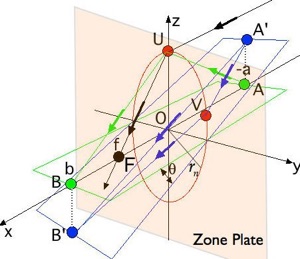Atelier Bonryu(E)
zone plate photography


Atelier Bonryu(E)
zone plate photography


Path of obliquely incident light waves
A zone plate is located on yz-plane (x=0) and the optical axis is the same as x-axis. The n-th zone (transparent) is shown by a red circle. Light waves from infinity arrive at the focal point F passing through an arbitrary point U on the n-th zone. Light waves from a point on the optical axis at a finite distance a from the zone plate pass through an arbitrary point on the n-th zone and arrive at the point B in phase. Light waves from an off-axis point A’ pass through an arbitrary point on the n-th zone arrive at a point B’ in phase.
Laboratory Zone Plate Photography
Principle of Zone Plate Photography
- Remark -
Remark#3: Image Formation by Obliquely Incident Light












